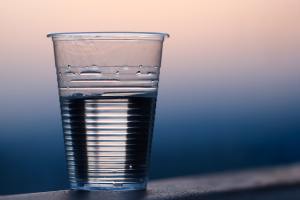The Very Basic Basics of Reverse Osmosis

Reverse osmosis has existed since 1959 as a means of water purification, but the smart odds are that you’ve never heard of it. If you have heard of it, you might have been put off by such a sciencey sounding term. Don’t worry about any of that, though, because today, we’re going to dive into this fascinating method of water purification. So let’s dive into the very basic basics of reverse osmosis.
Part 1) The System
Reverse osmosis (often abbreviated as RO) is incredibly intricate and precise, but there is a simple way to explain it. It can be roughly explained with one example: a colander. You’ve probably used a colander in the last month or two, so you know how to use a colander to strain liquid from food. Reverse osmosis has the same function, except instead of removing water from items, it removes items from water.
Of course, RO doesn’t literally use a colander; it uses a semi-permeable membrane with very tiny pores through which water is pressurized through. The theory though, is roughly the same. Sounds simple, right? If you want pure water, just run it through something that won’t allow anything but the water pass through. However, that’s not the end of the story. This is where we get into the mind-blowing details of the process.
Part 2) The Science
Reverse osmosis is the most effective method of water purification on the market because it is the most precise. It filters water down to the molecular level. So when water is pressured through the semi-permeable RO membrane, it leaves everything behind, and when I say everything, I mean, everything.
The size of a pore in the reverse osmosis membrane is 0.0001 (1/10,000) microns. Now that number already seems small, but however small you perceive that to be, it’s definitely smaller. Here’s some other measurements to prove my point. One inch is 25,400 microns. The width of a human hair has a range from about 40 to 300 microns. Bacteria range from 0.2 to 1 microns. Pesticide and herbicide molecules are 0.001 microns wide.
Too put all of this in less sciencey terms, the pores in a RO membrane are not just smaller than the width of pesticide molecules; they are ten times smaller. That’s why reverse osmosis is so effective. It takes a simple and direct approach, but then takes it above and beyond.
Part 3) The Usage
Now you might be thinking, “That’s great and all, but what can I actually use RO purified water for?” Well, with the level of purity that RO water has achieved, it should be reserved for consumption only, whether by cooking or drinking.
It’s tempting to take the highest grade of purified water and use it in all facets and faucets of your life. However, there is an important explanation to this question. With the exceptional purity of RO water, it’s actually more prone to absorb any other kinds of impurity. The water is essentially so devoid of materials, that it tends to latch onto anything it can. Running it through all of your house’s pipes would negate the point of the water’s purity because it would absorb anything within the pipes, including metal from the pipes themselves. For that reason, it’s meant to be enjoyed exclusively in the kitchen or a glass.
With that said, congratulations! You now know the very basic basics of reverse osmosis! If you’d like to move on to some more technical details, check out this PDF from the Water Quality Association. If you’d like to get an estimate on a reverse osmosis system of your own, click here to contact us.
Ready to Take Control of Your Water Supply?
Don’t wait for water shortages or unreliable sources to disrupt your life. With our Rainwater Harvesting systems, you can enjoy a sustainable, reliable, and completely self-sufficient water solution tailored to your home’s needs.

